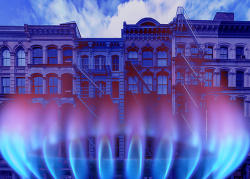With temperatures dropping into the 40s in New York, landlords are cranking on the heat.
But given the rising cost of fuel, many already had the jitters.
“There’s a lot of anxiety going into this heating season,” said Aaron Weber, an owner at Weber Realty Management, which oversees 400 apartments across Manhattan and Brooklyn.
Last winter, landlords were slammed by natural gas bills as high as 60 percent above the previous year’s levels. Utility providers such as Con Edison blamed a colder season and rising energy costs.
Since September 2020, the price of natural gas has more than quadrupled, surging to $8.81 per million British thermal units, a 16-year high.
Now, ahead of the official Oct. 1 start to the city’s heat season, which runs through the end of May, ConEd warns commercial heating bills could jump another 28 percent, and National Grid projects prices could climb by 30 percent annually as an even more frigid winter pressures already tight supplies.
For many landlords — particularly, rent-stabilized building owners already hammered by inflation — the price pop will mean fiscal pain. Some buildings may not have the reserves to survive the winter in good financial standing.
The long game
Landlords buy fuel in one of two ways: They lock in prices with multi-year contracts or pay market price each month.
Those entering the heating season mid-contract are in the best shape to weather recent price hikes.
Zachary Kerr, whose portfolio spans 1,000 units in Brooklyn, is about 18 months into a three-year agreement for natural gas. He’s paying around 46 cents per therm, a price he signed up for in 2021.
The move paid off handsomely: Natural gas prices in September rose to $1.08 per therm, according to National Grid.
But for owners with expiring contracts, the price jump will be a big budget hit.
“For owners who are coming out of contract, it’s like, how do you cope with that?” Kerr said.
Lose-lose
Landlords on month-to-month plans likely won’t fare much better.
Weber, for example, arranges gas service for the owners of nearly 30 buildings. As a result, he opts to pay that monthly market price.
His management firm views gas contracts as a gamble with someone else’s money. “It’s like you’re betting in the casino that prices are gonna go up,” he said. “So if prices go down, we just look like assholes.”
Sometimes they do go down. During the fracking boom of the 2000s, natural gas prices plummeted. But few are predicting that now. Heading into heating season, natural gas futures have been exceptionally volatile, reflecting great uncertainty about what gas will cost in the coming months.
That means landlords without contracts risk a huge jump from one month to the next. For rent-stabilized building owners, who cannot raise rents to compensate, increases have become unsustainable.
“If gas prices stay the same, it’s a problem. If gas prices go up even more, it’s a major problem,” Weber said.
Rent dearth
Come October, owners of stabilized apartments can bump the rent 3.25 percent on new one-year leases and 5 percent on new two-year leases.
But that won’t offset rising operating costs, which include utility expenses, a report last week by the landlord group Community Housing Improvement Program found.
When the Rent Guidelines Board penciled out the revenue boost owners would need to keep pace with costs, it estimated that fuel prices would dip by 1.7 percent. The board made a similar prediction last year, forecasting that fuel prices would grow by 0.1 percent and owners would need a 2 percent rent hike to keep pace with costs.
Read more



But the board voted for a half-year freeze last year, followed by a 1.5 percent hike. Fuel costs rose 19.6 percent during those 12 months, CHIP found.
“One of the things the board discussed before the vote was, ‘Well, we don’t need a larger increase because fuel costs are going to decrease,’” Kerr said. “But that didn’t happen.”
This year, CHIP estimates owners’ gas expenses — about 7 percent of their overall costs — will run about $150 annually per unit.
Add that to jumps in interest rates, maintenance and insurance, and CHIP expects the average stabilized building owner will have annual operating income of $293 per unit — not enough to cover repairs.
If a boiler blows mid-winter, for example, a replacement runs $172,600, the state estimates. It would take a 50-unit building nine years to save up for the swap, the report finds.
Oil premium
The 15 percent of city buildings still running on oil heat — typically, older properties offering affordable housing — face even more dire straits.
Over the course of the last heating season, prices for No. 2 heating oil surged over 127 percent from October to mid-May.
Weber said in January it cost about $6,034 to fill the tank of an HDFC co-op in Morningside Heights. By March, it cost $10,650.
“That was out of the blue,” Weber said. “We did not budget for that when we started the year.”
Luckily, a co-op owner in the building sold a unit, triggering a 5 percent flip tax.
“That saved them. They would have run out of cash if they didn’t have this flip tax income,” Weber said. “The timing was extraordinary.”
But the building likely won’t be able to swing another big price jump, the manager said. About 40 percent of its income goes toward fuel and most of the rest pays the mortgage.
Weber floated that the property could increase maintenance fees. “Otherwise, they’ll default on their mortgage,” he said.
“Record-breaking cold”
Owners are also bracing for higher delivery fees. If a cold snap sets off a spike in demand, utility companies will charge a premium for transportation, a CHIP spokesperson said. The Farmer’s Almanac is projecting “potentially record-breaking cold” and greater than average snowfall for the Northeast.
Last February, Kerr paid $8,252 for the gas to heat one of his properties. Delivery fees were another $7,700.
“It’s not cheap,” Kerr said.
Couple those variables with the rising cost of doing business and for many owners, particularly smaller and rent-stabilized landlords, the months ahead are looking long and dark.
Even those who locked in prices for this winter know their comfort is temporary.
“I’m very fortunate going into this year that I’m going to be okay, on the gas side,” Kerr said. “But I don’t know what’s going to happen in a year and a half when my contract expires, and that worries me.”
